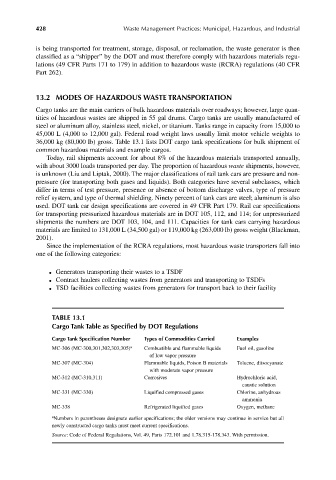Page 457 - Materials Chemistry, Second Edition
P. 457
CAT3525_C13.qxd 1/27/2005 12:30 PM Page 428
428 Waste Management Practices: Municipal, Hazardous, and Industrial
is being transported for treatment, storage, disposal, or reclamation, the waste generator is then
classified as a “shipper” by the DOT and must therefore comply with hazardous materials regu-
lations (49 CFR Parts 171 to 179) in addition to hazardous waste (RCRA) regulations (40 CFR
Part 262).
13.2 MODES OF HAZARDOUS WASTE TRANSPORTATION
Cargo tanks are the main carriers of bulk hazardous materials over roadways; however, large quan-
tities of hazardous wastes are shipped in 55 gal drums. Cargo tanks are usually manufactured of
steel or aluminum alloy, stainless steel, nickel, or titanium. Tanks range in capacity from 15,000 to
45,000 L (4,000 to 12,000 gal). Federal road weight laws usually limit motor vehicle weights to
36,000 kg (80,000 lb) gross. Table 13.1 lists DOT cargo tank specifications for bulk shipment of
common hazardous materials and example cargos.
Today, rail shipments account for about 8% of the hazardous materials transported annually,
with about 3000 loads transported per day. The proportion of hazardous waste shipments, however,
is unknown (Liu and Liptak, 2000). The major classifications of rail tank cars are pressure and non-
pressure (for transporting both gases and liquids). Both categories have several subclasses, which
differ in terms of test pressure, presence or absence of bottom discharge valves, type of pressure
relief system, and type of thermal shielding. Ninety percent of tank cars are steel; aluminum is also
used. DOT tank car design specifications are covered in 49 CFR Part 179. Rail car specifications
for transporting pressurized hazardous materials are in DOT 105, 112, and 114; for unpressurized
shipments the numbers are DOT 103, 104, and 111. Capacities for tank cars carrying hazardous
materials are limited to 131,000 L (34,500 gal) or 119,000 kg (263,000 lb) gross weight (Blackman,
2001).
Since the implementation of the RCRA regulations, most hazardous waste transporters fall into
one of the following categories:
● Generators transporting their wastes to a TSDF
● Contract haulers collecting wastes from generators and transporting to TSDFs
● TSD facilities collecting wastes from generators for transport back to their facility
TABLE 13.1
Cargo Tank Table as Specified by DOT Regulations
Cargo Tank Specification Number Types of Commodities Carried Examples
MC-306 (MC-300,301,302,303,305) a Combustible and flammable liquids Fuel oil, gasoline
of low vapor pressure
MC-307 (MC-304) Flammable liquids, Poison B materials Toluene, diisocyanate
with moderate vapor pressure
MC-312 (MC-310,311) Corrosives Hydrochloric acid,
caustic solution
MC-331 (MC-330) Liquified compressed gases Chlorine, anhydrous
ammonia
MC-338 Refrigerated liquified gases Oxygen, methane
a Numbers in parentheses designate earlier specifications; the older versions may continue in service but all
newly constructed cargo tanks must meet current specifications.
Source: Code of Federal Regulations, Vol. 49, Parts 172.101 and 1.78.315-178.343. With permission.

